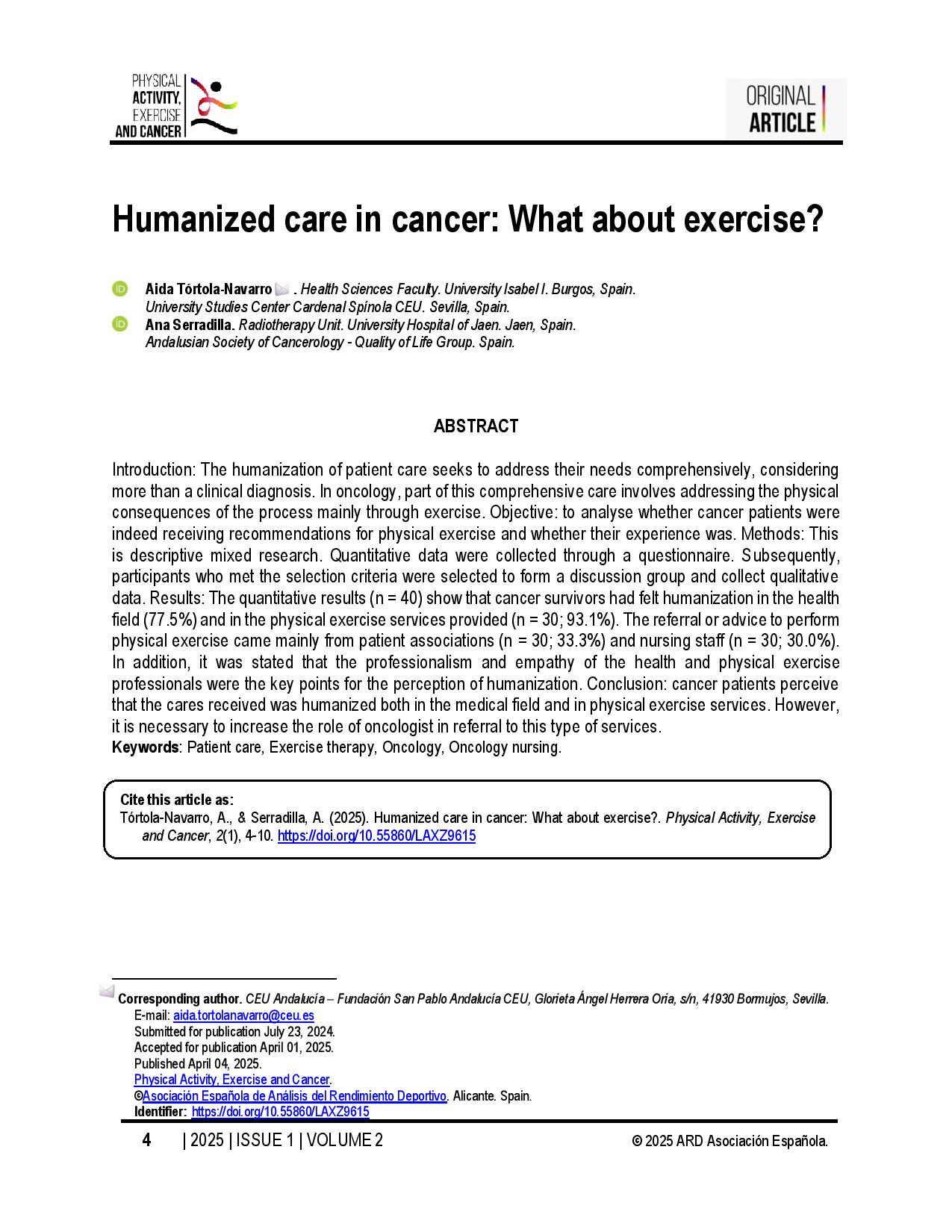Humanized care in cancer What about exercise?
Main Article Content
Abstract
Introduction: The humanization of patient care seeks to address their needs comprehensively, considering more than a clinical diagnosis. In oncology, part of this comprehensive care involves addressing the physical consequences of the process mainly through exercise. Objective: to analyse whether cancer patients were indeed receiving recommendations for physical exercise and whether their experience was. Methods: This is descriptive mixed research. Quantitative data were collected through a questionnaire. Subsequently, participants who met the selection criteria were selected to form a discussion group and collect qualitative data. Results: The quantitative results (n = 40) show that cancer survivors had felt humanization in the health field (77.5%) and in the physical exercise services provided (n = 30; 93.1%). The referral or advice to perform physical exercise came mainly from patient associations (n = 30; 33.3%) and nursing staff (n = 30; 30.0%). In addition, it was stated that the professionalism and empathy of the health and physical exercise professionals were the key points for the perception of humanization. Conclusion: cancer patients perceive that the cares received was humanized both in the medical field and in physical exercise services. However, it is necessary to increase the role of oncologist in referral to this type of services.
Article Details

This work is licensed under a Creative Commons Attribution-NonCommercial-ShareAlike 4.0 International License.
References
Beltrán-Salazar, O. A. (2014). Healthcare institutions do not favor care. Meaning of humanized care for people directly participating in it. Investigacion y Educacion En Enfermeria, 32(2), 194-205. https://doi.org/10.17533/udea.iee.v32n1a02
Bermejo Higuera, J. C., Carabias Maza, R., Villacieros Durbán, M., & Moreno Lorite, C. (2011). Humanización de la Atención Sanitaria. Importancia y significado en una muestra de población de la Comunidad de Madrid. Ética de Los Cuidados, 4(8).
Campbell, K. L., Winters-Stone, K. M., Wiskemann, J., May, A. M., Schwartz, A. L., Courneya, K. S., Zucker, D. S., Matthews, C. E., Ligibel, J. A., Gerber, L. H., Morris, G. S., Patel, A. V, Hue, T. F., Perna, F. M., & Schmitz, K. H. (2019). Exercise Guidelines for Cancer Survivors: Consensus Statement from International Multidisciplinary Roundtable. Medicine and Science in Sports and Exercise, 51(11), 2375-2390. https://doi.org/10.1249/MSS.0000000000002116
Diaz, K. A., Spiess, P. E., & García-Perdomo, H. A. (2023). Humanization in oncology care: A necessary change. Urologic Oncology: Seminars and Original Investigations, 41(2), 58-61. https://doi.org/10.1016/j.urolonc.2022.11.012
França, J. R. F. de S., Costa, S. F. G. da, Lopes, M. E. L., Nóbrega, M. M. L. da, & França, I. S. X. de. (2013). The importance of communication in pediatric oncology palliative care: focus on Humanistic Nursing Theory. Revista Latino-Americana de Enfermagem, 21(3), 780-786. https://doi.org/10.1590/S0104-11692013000300018
Giuliani, M., Martimianakis, M. A., Broadhurst, M., Papadakos, J., Fazelad, R., Driessen, E., & Frambach, J. (2020). Humanism in Global Oncology Curricula: An Emerging Priority. Current Oncology, 27(1), 46-51. https://doi.org/10.3747/co.27.5461
Grisales-Naranjo, L. V., & Arias-Valencia, M. M. (2013). Humanized care; the case of patients subjected to chemotherapy. . Investigación y Educación En Enfermería, 31(3), 364-376. https://doi.org/10.17533/udea.iee.17496
Herrero López, B., Cardeña-Gutiérrez, A., Godoy Ortiz, A., Gonzaga López, A., Grueso López, A. M., Nuño Alves, A., Ramírez Daffós, P., Rodríguez Sánchez, C. A., Rodríguez Pérez, Á. R., Sacristán Santos, V., Saura Grau, S., Sebio García, R., & Seguí Palmer, M. Á. (2024). Exercise in cancer patients: assistance levels and referral pathways-a position statement from the Spanish Society of Medical Oncology. Clinical and Translational Oncology. https://doi.org/10.1007/s12094-024-03546-w
Leininger, M. M. (2006). Culture care diversity and universality theory and evolution of the Ethnonursing Method. In M. Leininger & M. McFarland (Eds.), Culture care Diversity and Universality (2a, pp. 1-42). Jones and Barlett Learning.
Llopis Goig, R. (2004). Planificación básica y diseño de un estudio cualitativo con grupos de discusión. In Grupos de discusión (1a). ESIC Editorial.
Martínez Aguirre-Betolaza, A., Dobaran Amezua, A., Yagin, F. H., Cacicedo, J., Olasagasti-Ibargoien, J., & Castañeda-Babarro, A. (2024). Do Oncologists Recommend the "Pill" of Physical Activity in Their Practice? Answers from the Oncologist and Patients' Perspectives. Cancers, 16(9), 1720. https://doi.org/10.3390/cancers16091720
Moro Gutiérrez, L., & González Fernández-Conde, M. (2022). La atención humanizada en el cuidado del paciente oncológico. Cultura de Los Cuidados, 64. https://doi.org/10.14198/cuid.2022.64.22
Navarrete-Correa, T., Fonseca-Salamanca, F., & Barría, R. M. (2021). Humanized Care from the Perception of Oncology Patients from Southern Chile. Investigación y Educación En Enfermería, 39(2). https://doi.org/10.17533/udea.iee.v39n2e04
Segarra Vidal, B. (2024). Is it ethical today not to prescribe physical exercise in the gynaecology oncology consultation? Physical Activity, Exercise and Cancer, 1(1), 31-34. https://doi.org/10.61486/ICFZ7853
Todres, L., Galvin, K. T., & Holloway, I. (2009). The humanization of healthcare: A value framework for qualitative research. International Journal of Qualitative Studies on Health and Well-Being, 4(2), 68-77. https://doi.org/10.1080/17482620802646204
Tong, A., Sainsbury, P., & Craig, J. (2007). Consolidated criteria for reporting qualitative research (COREQ): a 32-item checklist for interviews and focus groups. International Journal for Quality in Health Care, 19(6), 349-357. https://doi.org/10.1093/intqhc/mzm042




